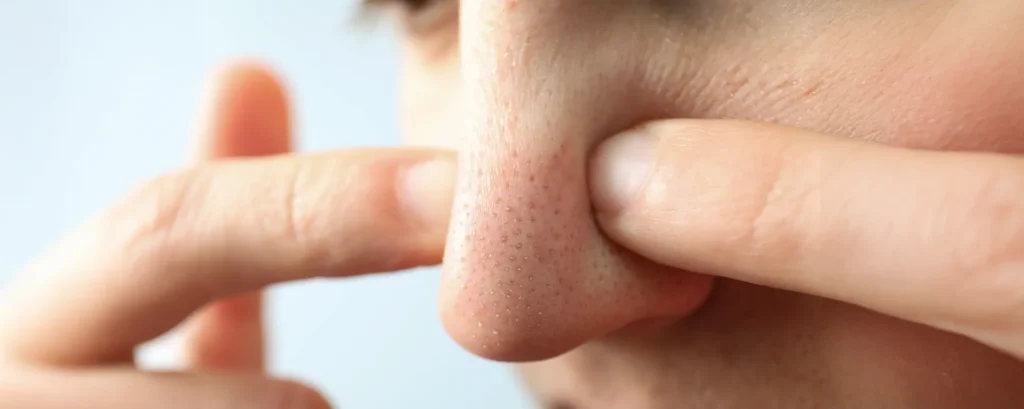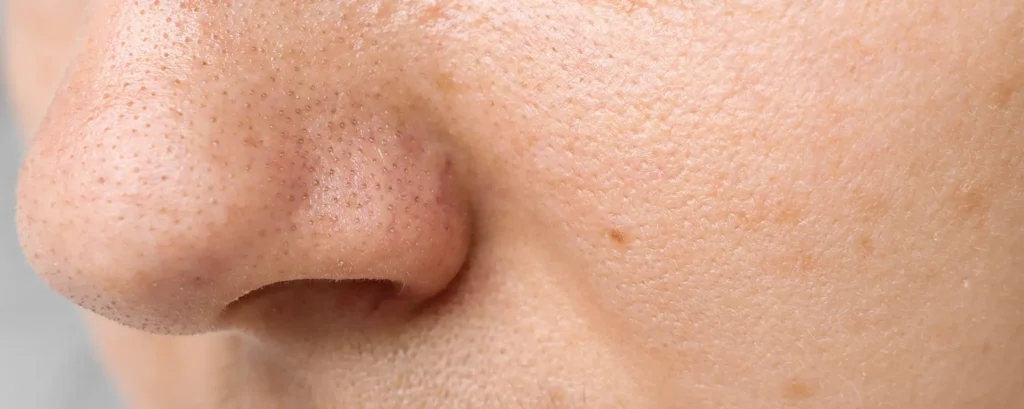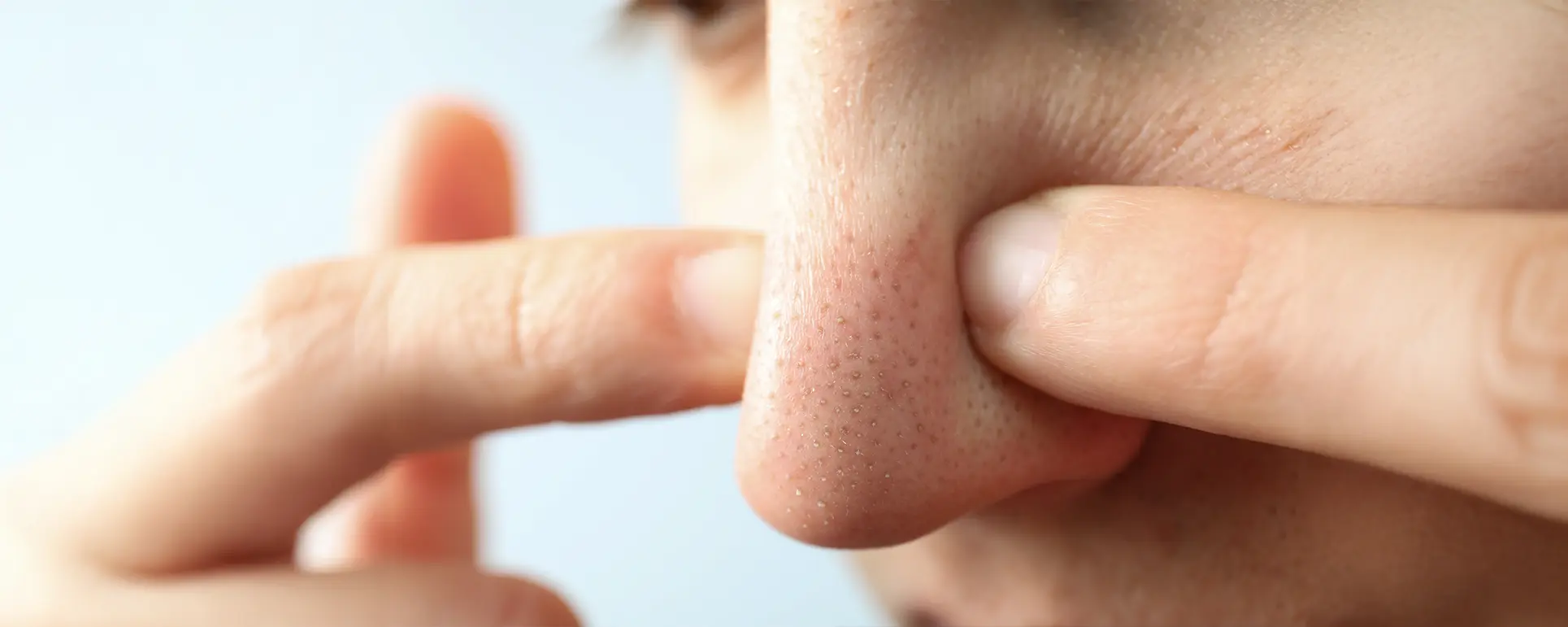If you’ve ever leaned close to the mirror and examined your nose, chances are you’ve noticed tiny, dark, or greyish dots scattered across the surface. They can look like small blackheads that stubbornly refuse to clear up, no matter how much you wash, scrub, or use pore strips. For many people, these persistent spots can be a source of frustration, leading them to believe their skin is always “clogged” or “dirty.”
However, what you’re often seeing are not blackheads at all they’re sebaceous filaments, a completely natural and essential part of how your skin functions. Unlike blackheads, which are considered a form of acne caused by clogged pores filled with excess oil, dead skin cells, and bacteria, sebaceous filaments are structures that line your pores and help guide sebum (your skin’s natural oil) to the surface. They are basically part of your skin’s oil management system, ensuring hydration and protection.
The key difference lies in their purpose and permanence. Blackheads can be treated and removed because they’re blockages, but sebaceous filaments will always return since they’re part of your skin’s anatomy. While you may be able to temporarily minimize their appearance with skincare, you can’t and shouldn’t try to get rid of them completely.
Understanding this distinction is important for healthier skincare habits. Instead of aggressively squeezing, scrubbing, or over-exfoliating your nose in an attempt to “clear” these dots, it’s better to manage oil production and keep pores clean with gentle, consistent care. That way, your skin looks smoother without causing irritation or long-term damage.
Consistency is key when it comes to dealing with sebaceous filaments. Incorporating products like salicylic acid for gentle exfoliation, retinoids to encourage cell turnover, and non-comedogenic moisturizers can help maintain balance without stripping the skin. Occasional treatments like clay masks may also temporarily reduce their visibility. Most importantly, understanding that these filaments are a normal part of skin physiology can help shift your perspective from trying to “eliminate” them to focusing on maintaining overall skin health.
If you’re ever unsure whether you’re dealing with blackheads or sebaceous filaments, consulting a dermatologist can provide clarity and prevent unnecessary damage to your skin. A professional can not only confirm the difference but also recommend treatments tailored to your skin type, lifestyle, and goals. This personalized approach ensures that you avoid harsh methods that may worsen irritation and instead adopt a routine that keeps your pores healthy, your skin balanced, and your confidence intact.
What Are Sebaceous Filaments?

Sebaceous filaments are tiny, naturally occurring structures that exist within the pores of your skin. They are most commonly seen on areas of the face where oil production is higher, such as the nose, chin, forehead, and sometimes even the cheeks. Unlike temporary skin concerns such as acne or blackheads, sebaceous filaments are permanent components of the skin and play an essential biological role in its overall health.
At their core, sebaceous filaments are made up of a combination of substances, including sebum (the skin’s natural oil), dead skin cells that shed from the lining of the pores, and microscopic hair fragments that line the pore walls. These elements come together to form thin, tube-like structures that line the inside of the pores, giving them a slightly visible appearance on the skin’s surface.
The main function of sebaceous filaments is highly beneficial: they act as natural channels that help guide and transport sebum from the sebaceous glands, which are located deeper in the dermis, up to the outer surface of the skin. Once the oil reaches the surface, it serves an important protective purpose by moisturizing the skin, supporting the barrier function, and preventing excessive dryness or irritation. In other words, sebaceous filaments are part of your skin’s natural self-maintenance system, ensuring that it remains hydrated, supple, and resilient against environmental stressors.
Visually, sebaceous filaments often appear as very small dots or pinpoints on the skin. Their color can range from light grey and yellowish to flesh-toned, depending on skin type and the amount of sebum present. They are usually uniform in size and evenly distributed, particularly in the T-zone (nose, forehead, and chin), where oil glands are most active. This uniform appearance is one way to distinguish them from blackheads, which are darker, irregularly scattered, and caused by clogged pores that oxidize when exposed to air.
It’s important to emphasize that sebaceous filaments are not a sign of poor hygiene or a skin disorder. In fact, everyone has them, regardless of skin type, age, or lifestyle. They simply tend to be more noticeable in individuals with naturally oily or combination skin, where the pores are more active in producing sebum. Trying to squeeze or aggressively extract sebaceous filaments is not recommended, as this can lead to irritation, enlarged pores, inflammation, or even an increase in oil production as the skin attempts to compensate for the disruption.
Instead of viewing sebaceous filaments as a cosmetic flaw, it helps to understand them as a normal and healthy part of your skin’s physiology. While certain skincare practices such as gentle exfoliation, clay masks, or oil-regulating products may temporarily reduce their visibility, it is not possible or necessary to eliminate them completely. Their presence reflects a balanced and functioning skin ecosystem.
In summary: sebaceous filaments are not a skin problem that needs fixing. They are a natural, permanent feature of the skin that supports hydration, protection, and balance. Accepting their role can help you shift perspective from over-focusing on “flaws” to appreciating the skin’s complex and intelligent self-care system.
How Are Sebaceous Filaments Different from Blackheads?

Although sebaceous filaments and blackheads may look somewhat similar on the skin, they are actually very different in both structure and purpose. Understanding these differences is important to avoid mistaking a natural skin feature for a problem that needs treatment.
Appearance:
Sebaceous filaments are tiny, usually uniform in size, and appear as faint grey, yellow, or flesh-colored dots on the surface of the skin. They are most commonly seen on the nose and surrounding areas, where oil production is naturally higher. In contrast, blackheads tend to be larger, darker, and more noticeable. Their dark color comes from the oxidation of sebum and debris when it is exposed to air, which gives them their characteristic black or deep brown appearance.
Cause:
The formation of sebaceous filaments is completely natural. They are created by the regular flow of oil and dead skin cells within the pores, helping to guide sebum to the skin’s surface. Blackheads, on the other hand, result from clogged pores. When excess oil, dirt, dead skin, and sometimes bacteria build up and get trapped inside a pore, it becomes blocked. Once the material inside the pore is exposed to oxygen, it oxidizes and turns dark, creating a blackhead.
Inflammation:
Sebaceous filaments are generally harmless and do not cause inflammation, irritation, or pain. They are simply part of your skin’s physiology and are rarely associated with discomfort. Blackheads, however, can sometimes become inflamed, especially if bacteria are present or if the pore becomes irritated. In some cases, untreated blackheads can even lead to breakouts or other forms of acne.
Removal or Treatment:
Sebaceous filaments cannot be permanently removed, because they are a normal and essential part of your skin’s function. At best, their appearance can be minimized temporarily through gentle exfoliation, clay masks, or extractions, but they will always return because the skin continuously produces oil. Blackheads, on the other hand, can be treated and managed more effectively. They often respond to skincare products containing ingredients like salicylic acid, retinoids, or benzoyl peroxide. In more stubborn cases, dermatologists can perform extractions or recommend advanced treatments such as chemical peels and microdermabrasion.
In summary, sebaceous filaments are natural, necessary structures that help maintain skin balance, while blackheads are a form of clogged pore that can lead to acne and require treatment if they become persistent. Recognizing this distinction can help you care for your skin more appropriately accepting sebaceous filaments as part of normal skin and targeting blackheads only when they pose a concern.
Why Do Sebaceous Filaments Become More Visible?
Even though sebaceous filaments are a natural and permanent part of your skin, there are certain factors that can make them appear more noticeable. While everyone has them, not everyone sees them as clearly, and this visibility is often linked to how your skin behaves and how well it is cared for.
Excess Oil Production
People with oily or combination skin types often notice sebaceous filaments more than those with drier skin. This is because oil (sebum) is produced in larger quantities, filling the pores more quickly. When more oil travels up through the pores, the filaments appear darker or more prominent on the skin’s surface. Hormonal changes, stress, diet, and even certain skincare products can also trigger the skin to produce more oil, which in turn enhances the appearance of sebaceous filaments.
Enlarged Pores
The size of your pores also plays a big role in how visible sebaceous filaments are. Some people naturally have larger pores due to genetics, while others may develop enlarged pores over time because of sun exposure, loss of skin elasticity, or aging. When pores are wider, the contents inside such as sebum and dead skin cells are easier to see, which makes the filaments appear more pronounced. This is why sebaceous filaments tend to be more obvious on the nose and central face, areas where pores are typically larger.
Improper Cleansing and Skin Care
Another reason sebaceous filaments may stand out is insufficient or improper cleansing. When dirt, sweat, and dead skin cells accumulate on the surface, they can mix with oil inside the pores, making filaments darker and more visible. Skipping regular cleansing, using harsh products that strip the skin’s barrier, or not exfoliating gently enough can all contribute to the problem. Instead of removing sebaceous filaments, these practices can make them more noticeable by creating imbalance in the skin.
In short, sebaceous filaments become more visible when excess oil production, enlarged pores, or buildup on the skin surface accentuates their natural structure. While they cannot be removed entirely because they are a part of healthy skin function their appearance can often be managed with consistent, gentle skincare practices that regulate oil, protect pore size, and maintain a clean surface.
Dermatologist-Approved Ways to Minimise the Appearance of Sebaceous Filaments

Since sebaceous filaments are a natural and permanent part of your skin, the goal is not to remove them completely because that is impossible but rather to make them less noticeable. These tiny structures play an essential role in guiding sebum (oil) from the sebaceous glands to the surface of the skin, which helps maintain hydration and protects your barrier. Dermatologists emphasise that sebaceous filaments are not a sign of poor hygiene or clogged pores, but simply a normal part of healthy skin function. Instead of trying to eliminate them, skincare should focus on reducing their visibility, refining overall skin texture, and keeping the pores from becoming congested.
Gentle Exfoliation
One of the most effective ways to minimise sebaceous filaments is through gentle, regular exfoliation. Exfoliation helps prevent excess buildup of oil and dead skin cells, which can make filaments appear darker and more obvious. Dermatologists typically recommend chemical exfoliants over physical scrubs because they are more precise and less damaging to the skin barrier. Salicylic acid, a beta hydroxy acid (BHA), is particularly beneficial because it is oil-soluble and able to penetrate deep into the pores, where it dissolves excess sebum and debris. Unlike harsh scrubs that may cause micro-tears, irritation, or even enlarged pores, salicylic acid works gradually and consistently to smooth skin texture. Over time, this reduces the contrast between sebaceous filaments and the surrounding skin, making them appear softer and less visible.
Clay Masks
Clay masks are another dermatologist-approved method to reduce the appearance of sebaceous filaments, especially for people with oily or combination skin types. Ingredients such as kaolin or bentonite clay are known for their strong oil-absorbing properties. When applied to the skin, clay gently draws out excess sebum and impurities from the pores, leaving the surface looking clearer and more refined. While this effect is temporary, it provides an immediate improvement in the skin’s appearance, often making sebaceous filaments less noticeable for a short period after use. Incorporating a clay mask once or twice a week can complement your skincare routine by keeping oil levels balanced and preventing the pores from looking congested.
Retinoids
Retinoids whether in the form of prescription-strength tretinoin or over-the-counter retinol are a gold standard in dermatology for improving pore visibility and overall skin texture. Retinoids work by increasing cell turnover, which prevents dead skin cells from accumulating and clogging the pores. This continual renewal process ensures that sebaceous filaments do not become overly prominent. Over weeks and months of consistent use, retinoids help regulate oil production, refine the appearance of pores, and create a smoother, healthier-looking complexion. Dermatologists often highlight that patience is key when starting retinoids, as results are gradual but long-lasting. For many, retinoids provide one of the most reliable long-term strategies for managing sebaceous filaments effectively.
Professional Extraction
In cases where sebaceous filaments appear especially visible and bothersome, dermatologists or licensed estheticians may perform professional extractions. This procedure involves carefully clearing out the pore without causing unnecessary trauma to the skin. However, it is very important to note that extractions should never be attempted at home. Squeezing or picking at sebaceous filaments can easily backfire, leading to skin irritation, enlarged pores, broken capillaries, or even permanent scarring. A professional, on the other hand, has the right tools and training to minimise risks while providing a temporary improvement in pore clarity. While the results are not permanent since sebaceous filaments naturally return professional extractions can be a safe option for those who want an occasional reset.
Consistent Skincare Routine
Perhaps the most crucial step in managing sebaceous filaments is maintaining a consistent, balanced skincare routine. Cleansing twice daily with a gentle, non-stripping cleanser helps remove surface oil, makeup, and dirt without disrupting the skin barrier. Harsh cleansers or over-cleansing can trigger rebound oil production, making sebaceous filaments even more visible. Incorporating hydrating products such as moisturisers and serums is equally important, as well-hydrated skin tends to look smoother and healthier. A balanced skincare routine ensures that the skin’s natural barrier remains intact, reducing the risk of irritation while keeping sebum levels under control. Dermatologists often stress that a “less is more” approach focused on gentle, consistent care is more effective than using aggressive treatments that can damage the skin in the long run.
Final Thought: Understanding and Managing Sebaceous Filaments Safely
Those persistent nose dots are often harmless sebaceous filaments rather than blackheads. For a personalised treatment plan and professional care, you can book a consultation at an Acne Clinic in London where dermatologists help reduce their appearance safely and effectively.
References:
- Mineroff, J. P., Hyde, J. T. & Hsu, S., 2023. A Case Report of Sebaceous Filaments. Cureus, 15(11), e48656. https://www.researchgate.net/
- Daglis, S., 2025. Sebaceous Filaments Explained: Causes, Facts, and Treatments. Rupa Health. https://www.rupahealth.com/post/sebaceous-filaments-explained-causes-facts-and-treatments
- Verywell Health, 2024. Sebaceous Filaments on Face: Treatments for Large Pores. Verywell Health. https://www.verywellhealth.com/sebaceous-filaments-8419336
- Wikipedia, 2025. Sebaceous filament. Wikipedia. https://en.wikipedia.org/wiki/Sebaceous_filament
